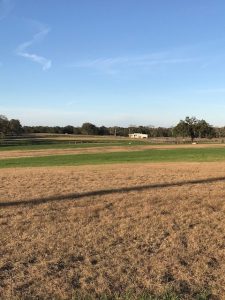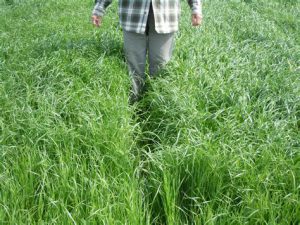 Driving through Marion County, “Horse Capital of the World”, even in the depths of winter I am amazed at the beauty of the large commercial farms located here. A particular topic of interest to me and one that I feel could have a real economic and environmental impact is a feeding/forage system for horses using annual ryegrass for winter forage.
Driving through Marion County, “Horse Capital of the World”, even in the depths of winter I am amazed at the beauty of the large commercial farms located here. A particular topic of interest to me and one that I feel could have a real economic and environmental impact is a feeding/forage system for horses using annual ryegrass for winter forage.
Part of the beauty I described during the cold, dry winter months is the sight of annual rye grass popping up around the gates to farms and around the various structures of the farm, perhaps even lining the perimeter of the farm. I propose planting ryegrass in your horse pastures instead of as a winter aesthetic! Ryegrass is one of the best winter annual forages to plant in this area and has the potential to produce a feed with over 70% dry matter and 20% crude protein. By planting annual ryegrass in the fall (October-November being the optimal time to plant) you can extend the grazing season by three months or more in some cases. Three months of horses eating quality forage in your pasture versus three months of having to purchase excess high quality hay that may be difficult to find some years. The cost breakdown of planting this winter forage is a no brainer!
By planting annual ryegrass in the fall you can extend the grazing season by three months or more in some cases.
A secondary benefit to planting annual ryegrass for winter forage is improved soil quality in your pastures. Typically, once the temperature drops below the optimum growing temperature for summer pasture, it will go into dormancy and that is when our feed bill increases significantly because the grazing capacity is greatly reduced. Besides an increase in supplemental feed costs, the lack of ground cover in the pasture will allow for the area to become easily denuded, planting annual ryegrass will maintain soil structure and allow for continuous green cover and nutrient recycling.
Annual ryegrass is one of the only forages that can be broadcasted instead of drilled and be successful, which makes for an easier establishment process with less equipment. Buying quality seed is extremely important; buy from a facility with good storage practices that sell varieties recommended by the University of Florida per variety trials conducted each year.
 Prior to planting your ryegrass, taking soil samples is crucial. This is simple and I am here to provide assistance if needed. This will provide a nutrient analysis of the soil in your planting area which will offer essential fertilization recommendations. Split fertilizer applications are optimal for best crop performance. Timing is key for successful ryegrass, you want to plant in the fall when temperature and moisture are ideal. Be aware that the sooner in the fall you choose to plant, the more competition that annual ryegrass will have with the existing summer perennial grasses (Bahia or Bermuda grass). Wait until the summer grasses begin to slip into dormancy so that the ryegrass can utilize the space and nutrients for its growth and not have to share with the Bahia or Bermuda grass.
Prior to planting your ryegrass, taking soil samples is crucial. This is simple and I am here to provide assistance if needed. This will provide a nutrient analysis of the soil in your planting area which will offer essential fertilization recommendations. Split fertilizer applications are optimal for best crop performance. Timing is key for successful ryegrass, you want to plant in the fall when temperature and moisture are ideal. Be aware that the sooner in the fall you choose to plant, the more competition that annual ryegrass will have with the existing summer perennial grasses (Bahia or Bermuda grass). Wait until the summer grasses begin to slip into dormancy so that the ryegrass can utilize the space and nutrients for its growth and not have to share with the Bahia or Bermuda grass.
Horses are not easy on a pasture, we all know this to be true, which is why we promote attention to stocking rates and sacrifice areas when discussing the management of horse pastures. Same goes during the establishment phase of your annual ryegrass, excluding animals from the area is critical. A minimum of 6-8”of growth is recommended prior to allowing animals to graze. Keep in mind that you want to graze the ryegrass no shorter than 3-4” before removing animals.
In conclusion, planting ryegrass in the fall can make for longer sustained pasture grazing and improved pasture conditions year-round. Having the added aesthetic from the lush, green ryegrass becomes ancillary to the benefits provided to your horses!
For more information: http://edis.ifas.ufl.edu/pdffiles/AG/AG10400.pdf
 0
0
